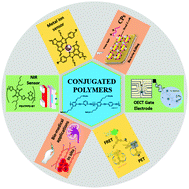Conjugated polymers – a versatile platform for various photophysical, electrochemical and biomedical applications: a comprehensive review
Abstract
In recent decades, there has been a significant quest for a viable medium for multiple applications. Many researchers have devoted all their utmost efforts to identifying such a medium. Finally in this context, conjugated polymers have proven to be a potential platform for a variety of applications due to their diverse nature. The conjugated polymer backbone is made of alternate electron donor and acceptor groups; the properties of such compounds can be tuned by altering the length of conjugation, adjacent group of monomers, energy levels, molecular interaction, etc. This alteration increases the light absorbance range that enables the molecule to be a photoluminescence active material for sensing toxic metal ions, organic molecules and gas detectors. Energy transfer, complexation, charge transfer and active chemical transformations are the common mechanisms of fluorescence based sensing application. Optimization of the HOMO and LUMO levels has been used as an efficient charge transfer ground between a conjugated polymer and analyte for photoluminescence and electrochemical sensing applications, and has subsequently been used in the construction of optoelectronic devices such as NIR sensors and flexible OLEDs. High compatibility conjugated polymers even made these giant molecules apt for mimicking biomolecules; some compounds were suitable for anti-bacterial application and even served as a drug delivery system. This review article intends to provide insights (2015–present) into versatile applications of conjugated polymers with the required diagrammatic explanation and a unique behavior of monomers including fluorene, carbazole, phenyl vinylene, triphenylamine, etc. Thus, we predict that this work will offer a comprehensive overview of an overall application of conjugated polymers and improve their applicability in multiple domains including portable sensors, flexible optoelectronic devices and future drug delivery processes.

- This article is part of the themed collection: 2021 Focus and Perspective articles


 Please wait while we load your content...
Please wait while we load your content...